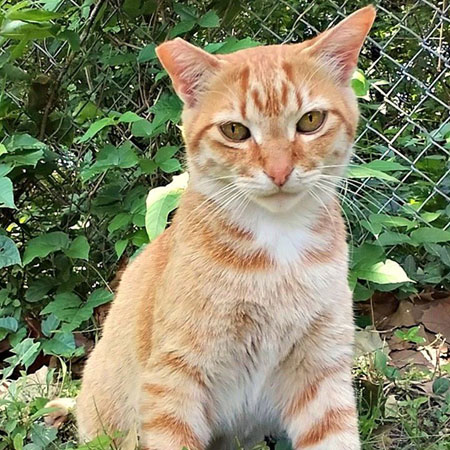What is a Community Cat?

A community cat is a free-roaming, unowned cat that lives outside. Community cats may be friendly, or they may be feral. Being “feral” means that a cat is not socialized to people – they cannot be pet or picked up, and usually run if you get too close. Whether feral or friendly, all community cats have some things in common – they call the neighborhood (or community) their home, and are given food, shelter, and protection from members of the community.
Community cats may live in neighborhoods, near business, or anywhere outdoors! Usually, these cats do not want to come inside and do not do well in shelters. Feral cats cannot be adopted, because they are so afraid of humans and are not able to adapt to being a pet.
A Solution for Outdoor Cats
Just because community cats can’t be adopted, doesn’t mean there aren’t ways to help. Kind hearted people all across the world volunteer time and resources to make sure these cats always have fresh food, water, and shelter.
Community cats are unowned, and don’t “belong” to a single person. Instead, they live in and belong to the community! We believe that when neighbors, property managers, residents, business owners, and coworkers come together to help community cats – awesome things happen!
Clermont Animal CARE Humane’s Community Cat Program believes in a happier, healthier world for cats – starting right here in Clermont County. Together, we can make a huge difference! Trap, Neuter, Return – or TNR – is the only effective and humane solution to the problem for feral cat overpopulation. With TNR, community cats are caught in humane traps, transported to the vet, and spayed or neutered and vaccinated. Once they have recovered from surgery, they are returned to their outdoor home.
TNR helps cats to be happier and healthier – and keeps communities happier and healthier, too! TNR means free-roaming cats are not populating neighborhoods anymore (no more kittens!) and being trapped and taken to the vet means that injuries and illnesses can be treated before the cats are released. Plus, being vaccinated prevents the development and spread of diseases in groups of outdoor cats. Not only are the numbers of cats in an area controlled by preventing litters from being born, but the cats in the area are healthier and make for much better neighbors!
How Does the Community Cat Program Help?

The overabundance of outdoor cats is a community-based issue, with community-based solutions! Our role is to bridge the gap between concerned citizens, animal advocates, and people caring for outdoors cats the resources needed. We provide traps, equipment, and training so that you can safely and effectively trap cats in your community. We also provide transportation to and from our veterinary partners.
If you are physically unable to trap or lack transportation to be able to bring cats to the shelter, our team is here to help.
We also work hard to help make sure caregivers are able to provide food and shelter to the cats in their neighborhoods year-round, and we equip communities to work together to resolve cat-related issues and nuisance complaints.
Getting Started

Got cats? Whether you care for community cats and are looking for assistance, know someone who can use a helping hand for the cats in their neighborhood, or spotted a group of feral cats somewhere in your neighborhood or in town – complete our outdoor cat spay and neuter form so that we can assist you!
Frequently Asked Community Cat Questions
By nature, feral cats are not adoptable. Feral cats are not socialized to humans – they do not want to be petted, picked up, and especially do not want to spend any amount of time at a shelter or in a person’s home! Returning feral cats to their territory after spay and neuter is undeniably the safest and most humane way to help them.
Every person has probably encountered a friendly cat in their neighborhood at least once. Just because a cat is friendly and outside does not mean that cat is lost or stray. They may be someone’s indoor/outdoor pet, or they may just be a community cat. If the cat is healthy and happy – there is no reason to remove them from their neighborhood. Remember – being friendly to humans does not mean a cat doesn’t have outdoor survival skills! Even though they may be adoptable, it doesn’t mean they need to be taken to a shelter. Plenty of cats enjoy living free outdoors, and members of the community welcome them onto their property – and sometimes even inside their homes! – for shelter and food. Bringing community cats – friendly or feral – into the shelter takes the space of cats who are truly in need. Relieving the influx of community cats to the shelter means that more resources can be used saving cats who are truly in need. Empty cages means cats can be pulled from other shelters where the risk of euthanasia is high and pet cats can be surrendered when their owners are no longer able to care for them. When you look at the big picture, it is clear that leaving community cats in their communities saves lives! Of course, every situation is unique, and we make sure to look at every call from every angle. If you are worried about a cat living outdoors, call us. We will always make the decision that is best for the cat.
Besides the fact that there just isn’t anywhere for these cats to go – relocating cats is not only time consuming for people, but it is stressful and even dangerous for cats. And most importantly of all – it is a temporary and ineffective solution.
Cats bond very strongly to their territory, and removing them from that territory causes a lot of stress. In order to safely relocate a feral cat, they must be confined for a minimum of 4 weeks in their new home, otherwise they will run away. Because of the stress of relocating – trapping, confinding, and acclimating to the new area – relocation is a last resort option, implemented only when the cats’ lives are in grave danger. Relocation should only be done by trained or experienced individuals.
Cats populate an area because there is access to resources like food and shelter. Because of their territorial nature, cats will defend an area from other cats to protect those resources. When you remove a group of cats from an area, it just means that they are no longer there to prevent more cats from moving in. It isn’t uncommon for people to “run off” or remove a group of cats from their yard just to have an entirely new group move in a few weeks later! In contrast – spaying or neutering all of the cats in an area prevents population growth because no more kittens are born, and the existing cats continue to monitor and protect the territory from newcomers. It’s a win-win!
Many local governments, property managers, and HOA’s and even some countries have attempted to resolve feral cat overpopulation by banning community members from feeding cats. And all of those groups have one thing in common – they still have a cat problem.
Not only are food bans inhumane – they just don’t work. The reality is, no one will ever completely stop every person in an area from feeding cats. Cats are also extremely resilient – if they don’t get food from people, they will find their own food. While some cats do hunt, they will likely supplement their hunting by other means – usually, they head to the trash. Food bans are implemented in an attempt to settle cat related issues, but in the end, they create more issues.
Instead, we promote aggressive, targeted TNR to stabilize the number of cats in an area, and give community members who care for community cats the tools and information they need to help those cats be good neighbors. We promote a regular feeding schedule and feeding appropriate amounts during daylight hours to reduce the number of other visitors like possums, skunks, raccoons and insects; feeding at designated feeding stations; and keeping feeding stations and shelter areas clean and tidy at all times.
Millions of cats enter animal shelters every year, and a large portion of those unwanted cats are kittens born to feral mothers. Shelters and rescues are overrun with cats! There are too many cats, and not enough homes for them. TNR is THE solution for ending the crisis of feline overpopulation. By spaying just ONE feral female cat, we prevent thousands of unwanted kittens. This relieved the burden on shelters, rescues, and member of the community.
Humane traps, sometimes called box traps, are set in a safe location where the cats live or are frequently seen. The traps are designed so that they do not harm the cat in any way. Once a cat is caught in a trap, it is covered with a towel or blanket to help keep the cat calm. Then, the cat is kept in a safe, indoor place until surgery or transported to the veterinary clinic right away. While at the vet, the cat is sedated and then given a physical exam by veterinary staff.. The cat is spayed or neutered, given a rabies vaccine, and an ear tip. An ear tip is the universal symbol that an outdoor cat has been spayed or neutered, where about a ¼ inch of the left ear is surgically removed. The ear tip is done while the cat is still sedated and does not hurt the cat – it is much like getting an ear piercing! Because the cartilage is so thin at the tip of the ear, it is usually healed within a couple of days and rarely do cats even notice they’ve had one done! The cat is placed back into the trap to safely wake up from anesthesia, and, once awake, the cat is given a small amount of food and water and allowed to rest overnight. The following day, the cat can be released back outdoors.
This simple process safely and effectively improves the lives of so many cats!

